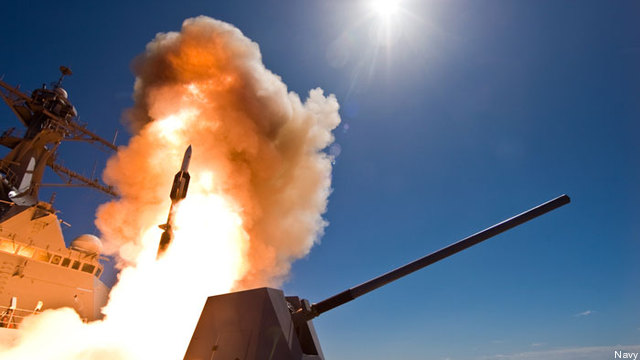Build Joint STARS: Leverage Competition, Lower Risk
Posted on
Air Force senior leaders must decide whether to build a new airborne ground radar surveillance capability. The Joint Surveillance and Target Attack Radar System (JSTARS) is a system boasting sophisticated radar, electronic, and communication suites installed in a modified Boeing 707. Over the last decade, this command and control aircraft, empowered by its Ground Moving… Keep reading →
Electronic Warfare ‘Growing’; Joint Airborne EW Study Underway
Posted on
ARLINGTON: After two decades of neglect, electronic warfare is — slowly — on the mend, the Pentagon’s Deputy Director for EW said yesterday. That includes a growing budget, a new (classified) strategy from the Office of the Secretary of Defense, increased interest from the leaders of all four armed services, and, most immediately, an ongoing… Keep reading →
Missile Defense Test ‘Realistic,’ Syring Insists
Posted on
PENTAGON: Yesterday’s $244 million missile defense test didn’t just hit an IBCM-like target for the first time in the history of the system: It hit a cutting-edge IBCM modeled on future North Korean weapons, complete with decoys to confuse defenders. “It actually replicated — without getting into classified details — an operational scenario that we’re… Keep reading →
Lockheed Pushes Q-53 Radar For Air Defense Vs. Russia
Posted on
Just weeks after winning $1.6 billion to build more Q-53 artillery-tracking radars, Lockheed Martin is pushing the Q-53 hard as a triple-threat solution to drones and manned aircraft as well. AN/TPQ-53s, to use their full name, have already been tested successfully against drones, helping Lockheed win a $28 million contract to upgrade their software to do… Keep reading →
New Missile Defense Radar Passes Key Stage: Lockheed LRDR
Posted on
As anxiety rises over North Korean rocket tests, the Missile Defense Agency needs better radar to tell threats apart. Which of those distant blips is an InterContinental Ballistic Missile (ICBM) warhead capable of hitting the US? Which is a burnt-out rocket boaster coasting harmlessly through space? Which is a decoy warhead designed to make MDA… Keep reading →
Crunch Time For Army Missile Defense Network, IBCS
Posted on
WASHINGTON: Northrop Grumman‘s IBCS network could revolutionize how the Army does air and missile defense, if they can get the software to stop crashing. Since Pentagon testers found in February 2016 that the system had to abort, on average, every six to eight hours, the program has worked hard to make the software “more robust,”… Keep reading →
Link Army, Navy Missile Defense Nets: Adm. Harris
Posted on
SAN DIEGO: The Army and Navy must link their missile defense systems into a single network so Navy weapons can hit targets spotted by Army radars and vice versa, the chief of Pacific Command said today. That’s a daunting technical task but, if surmounted, it could dramatically improve defense against North Korean, Chinese, or Russian… Keep reading →
Achilles Heel Of Army Air & Missile Defense: The Network
Posted on
ARLINGTON: The Russians aren’t just deploying new treaty-breaking, nuclear-capable cruise missiles. They’re also fielding sophisticated cyber and electronic warfare systems that can hack or jam our defenses against such missiles. In fact, no military mission is more dependent on high-speed data networks than air and missile defense — but no military system is more vulnerable than those… Keep reading →
At Red Flag ‘It’s Tough To Be Legacy Aircraft In An LO World’
Posted on
WASHINGTON: “You get whacked a lot.” Those are the words of someone who should know, the leader of the aggressor squadron at Red Flag, the man who tries to kill U.S. forces. Lt. Col. Tyler Lewis, commander of the 57th Adversary Tactics Support Squadron at Nellis Air Force Base, echoed comments we’ve heard before, that… Keep reading →
DARPA Ups Funding For Autonomous Electronic Warfare Work
Posted on
WASHINGTON: DARPA is taking another step toward building autonomous electronic warfare systems with a small contract award to BAE Systems. Artificial intelligence and autonomy loom large in the Pentagon these days. And electronic warfare, much more quietly, dominates a great deal of thinking across the services these days after we’ve watched how the Russians operate against Ukraine… Keep reading →










